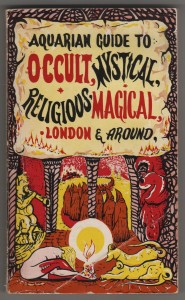 Edited by the specialist in such books, Francoise Strachan, and published in 1970 by the Aquarian Press, the Aquarian Guide to Occult, Mystical, Religious, Magical London and Aroundis a handy paperback directory of practices, beliefs, individual practitioners, groups, national and international societies in the metropolis and its environs together with various short features on spells and associated esoteric matters.
Edited by the specialist in such books, Francoise Strachan, and published in 1970 by the Aquarian Press, the Aquarian Guide to Occult, Mystical, Religious, Magical London and Aroundis a handy paperback directory of practices, beliefs, individual practitioners, groups, national and international societies in the metropolis and its environs together with various short features on spells and associated esoteric matters.
For someone fascinated by the Occult at this fag end of the hippy movement, this was probably the most definitive guide on the market. Certainly we at Jot HQ haven’t come across anything like it. The most interesting aspect of the book is the chapter listing the esoteric societies that were flourishing in the UK in this period. Some have disappeared without trace over the past 48 years; others are still going strong. In the spirit of discovery we thought it would be instructive to mention a few of the more prominent and outlandish outfits around in 1970.
The Order of the Cubic Stone
This was run by ‘ Wardens’ and had its HQ at the ‘ Lodge’ in Penn, near Wolverhampton, a rather dreary village on the edge of the Black Country and one of the last places you would expect to find such an outfit. Its aim was to ‘ train its students in the group’s approach to Ceremonial Magic’ and their system was based on the Qabalah and The Golden Dawn. The Order also had its own system of ‘Enochian Magic’. I wonder if this was anything to do with Enoch Powell, who was a prominent figure at the time and who lived just a few miles from Penn. Today, its leading light is Mr David F. Edwards, who has his own website, where you can read a little prayer he has composed just for you.
The Institute of Pyramidology.
Founded in London in 1940 by Adam Rutherford, who in 1967 moved the HQ to his modest Victorian villa in Station Road, Harpenden. The building is still there but Rutherford died in 1974. Apart from Eric Morecambe, who I don’t think was at all interested in the symbolism of pyramids, the only other notable figure associated with Harpenden was the brilliant gay artist and poet Ralph Chubb (see Bookride ), who was born there.
Rutherford was convinced that a link existed between the measurements of the Great Pyramids of Egypt and theories concerning the Lost Tribes of Israel. He himself was a member of the sect known as the British Israelites, which had its origins in the seventeenth century, and which argued that the races of Western Europe—and in particular the British—were descendants of the ten tribes of Israel. In its heyday the sect was dominated by various eccentric nonconformist ministers—many from America—although a few notable and reasonably intelligent individuals, such as Admiral John Fisher (1841 – 1920), Patience Strong and Mary Baker Eddy, were also members. The Institute of Pyramidology survived the death of its founder and today can be found alive and quite well in Chesham, Bucks.
The Arthur Findlay College.
In 1923 Arthur Findlay. a businessman with an interest in spiritualism , bought Stansted Hall, a large Victorian pile in extensive grounds near Stansted Mountfitchet, Essex. On his death in 1964 he bequeathed it for ‘the advancement of Psychic Science and as a Home for Spirit Healing’. In 1970, according to the Guide, the facilities were modest enough. There was ‘ a healing Sanctuary ‘ a ‘Church for meditation and the holding of religious services … a Medical Superintendent, and …facilities for conferences, week-end schools and special study courses.’ Forty-eight years later the centre now boasts of being the ‘world’s foremost College for the advancement of spiritualism and psychic sciences ‘. Over fifty tutors teach there and its fees seem to be remarkably cheap—just £425 for a week of study that includes accommodation and all meals. One journalist who spent a week there called the College ‘a Hogwarts for adults’.
The Atlantis Research Centre.
Founded in Rome by Mr J. Egerton Sykes in 1945, at the time of the Guide it was based at the rather suburban-sounding Ferndown Road, Hove. Advertising itself as ‘the only body conducting valid research into the problems of Atlantis ‘, it had achieved by this time its aim of gaining acceptance for its controversial dogma.
At the same address could be found the Hoerbiger Institute. Founded in 1913, long before space travel was ever considered, it sought to prove that a cosmic cause lay behind the Atlantis catastrophe. By 1970, following enormous advances in such travel, the Institute argues that it may now be possible to check up ‘details on the spot’. Sykes died in 1986, and although the Atlantis Research Centre seems to have died with him, scholarly arguments in favour of Atlantis continue to be published.
To be continued… [RR]
